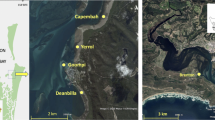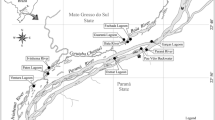Abstract
An analysis of living and dead components of a population of deep-sea agglutinated Foraminifera reveals that both segments of the fauna are dispersed nonrandomly on a scale of centimeters. Significant positive correlations between the distribution of living and dead individuals in several species imply that small-scale patch structure in this environment may persist for more than one generation. Mechanisms maintaining such structure may include habitat selection and reproductive patterns and suggest that dispersion pattern is the result of an active interaction between amimals and a heterogeneous physical and biotic environment.
Similar content being viewed by others
Literature Cited
Bernstein, B.B., R.R. Hessler, R. Smith and P.A. Jumars: Spatial dispersion of benthic Foraminifera in the central North Pacific. Limnol. Oceanogr.23, 401–416 (1978)
Christiansen, B.O.:Spiculosiphon radiata, a new Foraminifera from northern Norway. Astarte1964 (25), 1–8 (1964)
Connell, J.H.: Spatial distribution of two species of clams,Mya arenaria L. andPetricola pholadiformis Lamarck, in an intertidal area. Rep. Invest. Shellfish. Mass.8, 15–25 (1955)
Dayton, P.K.: Competition, disturbance and community organization: the provision and subsequent utilization of space in a rocky intertidal community. Ecol. Monogr.41, 351–389 (1971)
Enright, J.T.: Distribution, population dynamics and behavior of a sandbeach crustacean,Synchelidium sp., 255 pp. Ph.D. thesis, University of California, Los Angeles 1961
Grassle, J.F. and H.L. Sanders: Life histories and the role of disturbance. Deep-Sea Res.20, 643–659 (1973)
——, R.R. Hessler, G.T. Rowe and T. McLellan: A study of the bathyal megafauna using the research submersibleAlvin. Deep-Sea Res.22, 457–481 (1975)
Hessler, R.R. and P.A. Jumars: Abyssal community analysis from replicate box cores in the central North Pacific. Deep-Sea Res.21, 185–209 (1974)
Limars, P.A.: Environmental grain and polychaete species diversity in a bathyal benthic community. Mar. Biol.30, 253–266 (1975)
—: Deep-sea species diversity: does it have a characteristic scale? J. mar. Res.34, 217–246 (1976)
Uoeblich, A.R. and H. Tappan: Protista 2.In: Treatise on invertebrate paleontology, Part C. pp 1–900. Ed. by R.C. Moore. Lawrence, Kansas; University of Kansas Press 1964
Loucks, O.L.: Evolution of diversity, efficiency and community stability. Am. Zool.10, 17–25 (1970)
Martin, R.E. and D.C. Steinker: Evaluation of techniques for recognition of living Foraminifera. Compass, Cambridge50, 26–30 (1973)
Reys, J.P.: Analyses statistiques de la microdistribution des espèces benthiques de la région de Marseille. Téthys3, 381–403 (1972)
Rokop, F.J.: Reproductive patterns in the deep-sea benthos. Science, N. Y.186, 743–745 (1974)
Solbrig, O.T. and G.H. Orians: The adaptive characteristics of desert plants. Am. Scient.65, 412–421 (1977)
Thistle, D.E.: Harpacticoid copepods: a problem in deep-sea diversity maintenance, 180 pp. Ph. D. Thesis, University of California, San Diego 1977
Turekian, K.K., J.K. Cochran, D.P. Kharkar, R.M Cerrato, J.R. Vaisnys, H.L. Sanders, J.F. Grassle and J.A. Allen: Slow growth rate of a deep-sea clam determined by228Ra chronology. Proc. natn. Acad. Sci. U.S.A.72, 2829–2832 (1975)
Author information
Authors and Affiliations
Rights and permissions
About this article
Cite this article
Bernstein, B.B., Meador, J.P. Temporal persistence of biological patch structure in an abyssal benthic community. Marine Biology 51, 179–183 (1979). https://doi.org/10.1007/BF00555197
Accepted:
Issue Date:
DOI: https://doi.org/10.1007/BF00555197




